Description
- 【FOLDABLE AND LIGHTWEIGHT EASY TO STORE】– This solar panel photovoltaic packs 220W of power yet is only 1.1inch(2.8cm)thick and weighs only 9.7lb(4.4kg), making it easier to mount,transport, hang, and remove.
- 【COMPLETE KIT,WORKS OUT OF THE BOX 】– Solar charger for all 24V batteries ,with its 36V optimum power voltage.Protection against: overcharging, overload, short-circuit.
- 【PERFECT CHOICE FOR OUTDOOR AND EMERGENCY LIFE】– 9.85ft (3m) cable length from panel to controller, For most power stations (Jackery,Goal Zero,Ecoflow,Paxcess) and 24-volt batteries(AGM,LiFePo4,Deep cycle batteries),RV,car,boat,trailer,truck,pumpa,camping,van,emergency power.
- 【PUT A LOT OF POWER INTO YOUR BATTERY BANK】– powerful high conversion efficiency with high efficiency monocrystalline solar cell, you will get greater power efficiency even though the panel is smaller than a traditional model.Maximizes system output by reducing mismatch loss.
- 【SUPPORTING BRACKET AND EXTENSION CABLE】–The store additionally sells a special bracket for flexible folding boards and a 19.7Ft(6m)XT60 to XT60 extension cable.



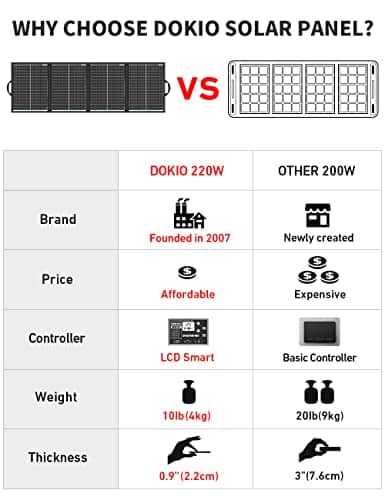
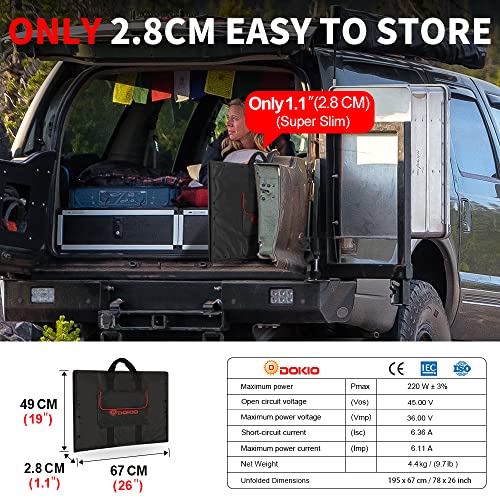
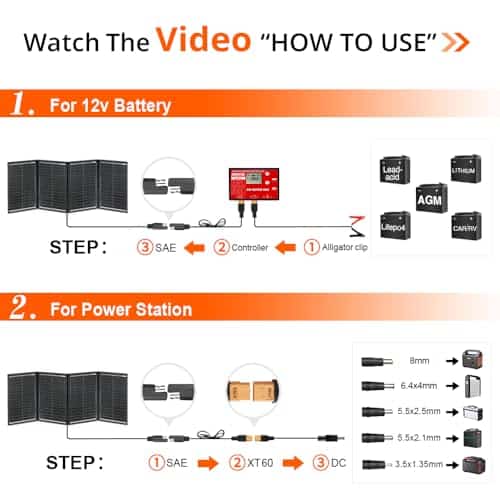

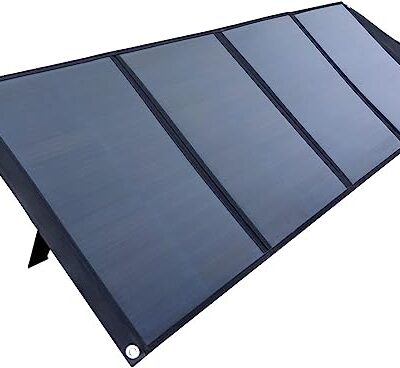
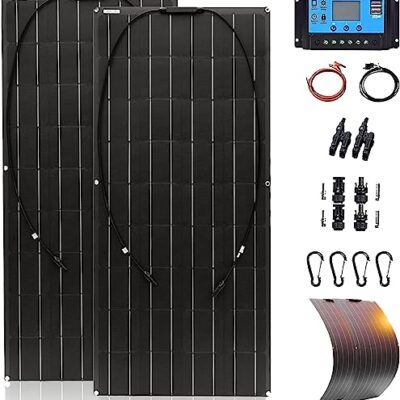
Debra –
Some say the fabric holding the panels together does not hold up well, seems ok, time will tell.
g.wray –
Absolutely great value for the price! Cannot stress enough for the money these are the best portable solar panels on the market! Keep a 100 and a 160 watt set in my travel trailer at all times!
Mark0 –
Please keep in mind that when it comes to solar panels the wattage rating usually equates to what is possible under laboratory conditions and just about never can be recreated in the real world. With that said, here’s my review:
As the headline reads, this is not exactly ‘light’. Surely easy enough for one person to move around and deploy and it folds down to a size that was easy enough to find room for behind the front seat of my truck. Since my RV already has a decent MPPT charge controller I decided I’d add on to the existing one (besides the included controller that came as part of the ‘kit’ HAS to be protected from the elements (direct sun & moisture) so was of little use to me to use along with my existing one.
The ‘kit’ came with a ~10′ cable that has connectors on both ends to use hooking it up. One end has a SAE connector that plugs into the panel and the other end I cut off and replaced with Anderson connectors. A word of caution here: Due to SAE’s ‘keying’ the +/- wires will reverse unless a little SAE-2-SAE adapter is used to change the polarity of the wires.
Given I don’t live in a LAB and I’m above the 45th I did not have high expectations for this panel. However it was a bright and sunny day in May and with a clear view of the sky (not a cloud in it) I set up the panel in my front yard. My existing solar panel (68W) was putting out ~40W when I plugged Dokio in parallel to it.
The solar panel wattage reading on my phones Bluetooth app went from ~40W to ~210W after plugging in the Dokio – showing that the Dokio 220W panel was providing ~170W of the ~210W total.
IMHO: not bad!
I plan on adding a fused SAE connector on my RV and keeping the panel behind the front seat of my truck. While the included cable is far to short (I ordered a 25′ SAE-2-SAE cable from Amazon) this will come in handy to add more ‘juice’ while I’m out in the wild – which is mostly what I do when I go out camping, I rarely have RV hookups even when I camp at official campgrounds. (I’m a boondocker!)
Granted, had I not already had a better solar controller installed I could of wired up and installed the one included in the kit. Sure, it is fairly basic but at least it has different battery type settings so you can match it to what your using.
I should note that when my panel kit arrived all that showed up was the panel box, nothing else! I contacted Amazon which asked me to contact the vendor and within 24hrs they responded and 48hrs later a FEDX truck dropped off the rest of the kit! I’d say very good support from the vendor!
To conclude I’d say that so far I’m happy with my purchase and the support I’ve gotten from the vendor. 🙂
UPDATE (9/22/2022): I’ve tried using the panel a number of times since purchase. As an example, I currently have it set in my front yard attempting to charge a power brick. While @ 9AM the sun is low in the sky the entire panel is ‘lit’ with sunlight but only putting out ~50W of power. As a ‘control’ I also plugged in a 100W panel and only got 25W out of it.
K. Peterson –
Bought 2 of these and took them on an 8 day boondocking camping trip in my 5th wheel to charge my Goal Zero Yeti 1000 power station. My wife and I use the Goal Zero Yeti 1000 to run our CPAP machines at night. I also used them to charge the 5th wheel batteries. Because of several factors (like clouds and the way I just threw them flat on the ground), I still had to run my gas generator a few times. Here is what I discovered:
1. I love these panels and just bought a third one. I also have two heavy Goal Zero 100W briefcase solar panels but they are so heavy I don’t like them. Much prefer the DOKIO 160W 18V Portable Solar Panels. Much easier to store.
2. They never produced 160W but my Goal Zero 100W panels never produced 100W either.
3. I love the battery management control box that comes FREE with the DOKIO 160W 18V Portable Solar Panel. I can hook it directly to my 5th wheel lead acid batteries and charge them to full capacity in a few hours (time varies because of lots of reasons).
4. The cheaper DOKIO 160W 18V Portable Solar Panels don’t have a kick stand so I had to lay them against a rock or just lay them flat on the ground. This made them less efficient but I didn’t have to keep adjusting them like I had to do on the Goal Zero briefcase 100W ones.
5. For the price of one 100W Goal Zero panel I can buy 2 DOKIO 160W 18V Portable Solar Panels.
6. In the morning I lay them flat on the ground, hook them up and don’t mess with them until the sun
goes down.
7. I just bought a third one and hope I won’t have to run the gas generator at all (depending on the weather). If three isn’t enough I will buy a fourth one and leave the Goal Zero ones at home.
Bottom line: If money is no problem the best solution is to have permanent solar panel system installed on the roof of your RV. But if you buy solar panels you can’t go wrong with these DOKIO 160W 18V Portable Solar Panels. Besides while I’m saving up for my home Tesla solar panels and back up batteries, I can use them at home for emergencies. Easy to lift and slim to store in the garage. Highly recommended.
EDUARDO –
Es ligero y eficiente, lo he usado sin problemas para cargar mis dos unidades Ecoflow River y River mini. Espero utilizarlo pronto para cargar baterías de 12 volts
Richard Milligan –
Comparto la opinion de otras personas, los materiales se sienten de buena calidad y cumple su función de cargar el generador solar, pero con sol al 100% no he conseguido mas de 60 Watts, que está lejos de ser los 160 watts que presume la publicación, con 100w me daría por bien servido, pero solo 60w por el precio me parece insuficiente.
A.M. Biggs –
Producto bueno, no he tenido la oportunidad de usarlo al 100, pero ha pasado las pruebas
Alfonso Garcia –
Good value for the money
Debra –
Design & Portability:
One of the standout features of this solar panel is its foldable design. It’s incredibly convenient for transport and storage, making it a great option for camping trips, road adventures, or emergency preparedness. The panel folds up neatly, so you can easily stow it in your vehicle or carry it with minimal hassle.
Performance:
The panel is advertised as a 160W unit, but in my experience, it only maxed out at 75W. This significant discrepancy means you might not get the power output you expect, especially if you’re relying on it for substantial energy needs. For instance, it took around 4.5 hours to charge my Bluetti power station to just 14%. While this could be useful in a pinch, it’s not ideal if you’re looking to rapidly replenish your battery or power larger devices. It could be user error, but I have a 100W non-portable panel that hit 90W in similar conditions.
Usefulness:
This panel could be handy in situations where you need a portable power source and can afford to wait longer for a charge. It’s fine for small, low-power devices or if you’re not in a hurry to get your battery levels up. However, for serious power needs or quicker charging, you might want to consider a higher-wattage or more efficient panel.
Conclusion:
The foldable 160W portable solar panel offers excellent portability and could be a useful tool if you’re in a tight spot. However, the actual power output falls short of expectations, so keep this in mind if you’re relying on it for significant energy needs. It’s a decent backup option but may not be the best choice for primary power generation.
Jose –
Worth it and the size is so small